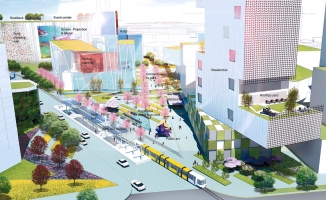Using Built Environment Strategies to Achieve 2030 Sustainability Goals
Using Built Environment Strategies to Achieve 2030 Sustainability Goals
The following is part of series from Cuningham's experts for Sustainable Brands, a global community that is on the forefront of making the case that embedding environmental and social purpose into the core of a brand is the future of business.
As a CSO or COO of a company striving for sustainability, what contribution can you expect of your built environment team? That’s the question we address in this first of a series of articles about decarbonization, regeneration and circularity in the built environment.
Every day, it seems another major corporation makes a public commitment to achieve ambitious goals of reducing its greenhouse gas emissions and carbon footprint by 2030. Sound familiar? Achieving such a commitment in this “decade of action” requires innovation in both management and leadership. Many organizations are realizing that they need to go beyond sustainability, but how?
New leadership partnerships between a company’s Chief Sustainability Officer (CSO), Chief Operations Officer (COO) and directors of its departmental functions responsible for the carbon footprint of its built environment (real estate, properties and facilities) will become critically important. As a CSO or COO of a company striving for sustainability, what contribution can you expect of your built environment team? That’s the question we address in this first of a series of articles about decarbonization, regeneration and circularity in the built environment.
By forging a supply chain coalition of internal and external partners, you can expect a significant contribution toward your carbon-reduction goals. This will require accountability and transparency in business practices, sourcing of materials, and waste streams.
Gary Miciunas
Director of Strategy
Making your built environment supply chain accountable and transparent
The “built environment” is a prime culprit of waste and pollution in many ways. According to the World Green Building Council, construction and operations contribute 39 percent of global CO~2~ emissions — with building materials and construction accounting for 11 percent and building operations accounting for another 28 percent. Beyond emissions, 40 percent of solid waste finding its way to landfills is attributable to construction and demolition activities.
The reality is that 80 percent of this downstream waste and pollution is a consequence of decisions made during the design stage of products, services and environments. Clearly, the design opportunity to eliminate waste and minimize pollution is significant. By forging a supply chain coalition of internal and external partners, you can expect a significant contribution toward your carbon-reduction goals. This will require accountability and transparency in business practices, sourcing of materials, and waste streams.
Applying a trio of allied strategies to the built environment
Strategies to achieve decarbonization, regeneration and circularity are allies on your sustainability journey toward a low-carbon future. The following are three prominent strategies

Decarbonization
Decarbonization phases out carbon dioxide emissions by decreasing reliance on fossil fuels. By focusing on reducing operational carbon in your supply chain, your built environment becomes far more efficient. In most built environment portfolios today, the current ratio of operational carbon and embedded carbon is most likely in the range of 60/40. As you get more aggressive in achieving operating efficiencies, and you implement procurement standards to reduce embedded carbon of all materials and products used, you can approach a 40/60 ratio or better.

Regeneration
Regeneration involves restoring living ecosystems by eliminating fossil fuel usage and relying only on alternative energy sources. Regeneration strives to improve human health and wellness as well as all living systems by producing positive ecosystem services. Imagine buildings that produce more energy than they consume, clean the water they use, and purify the air they breathe. This not only keeps emissions out of the atmosphere, but also keeps more carbon in the earth.

Circularity
Circularity strives to eliminate all waste and negative externalities — i.e. pollution — by making better design decisions through closed-loop systems that separate natural and technical resources. It applies circular economy business models and principles to the built environment. Circular strategies move beyond return on investment (ROI) based on life-cycle analysis — they anticipatec end-of-life and end-of-use scenarios in a value-cycle analysis of reducing, reusing and recovering resources and materials by design. Shifting your mindset from supply chains to value chains creates a built environment that improves infrastructure performance, extends the usefulness of life and value of materials, and improves the health of people and the planet.
The decade of action ahead inspired by design
The challenge for teams racing to achieve sustainability goals by 2030 goes beyond improving existing systems to designing new systems across all areas of your enterprise. We believe a good place to start is with your built environment team exploring the potential of decarbonization, regeneration and circularity strategies to make a significant contribution to your overall efforts.



